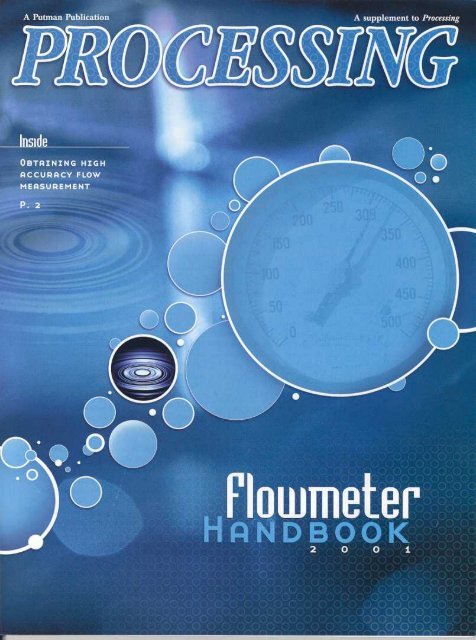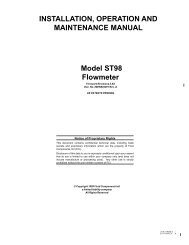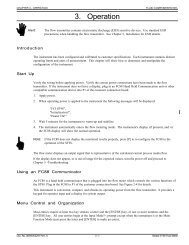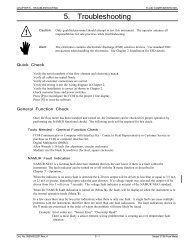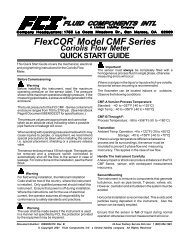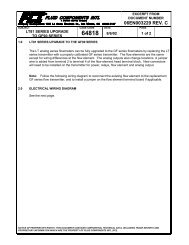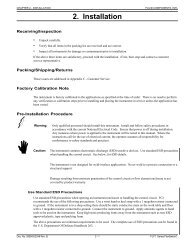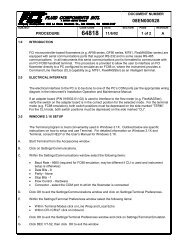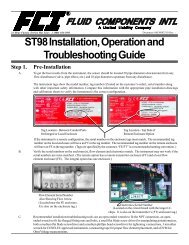Untitled - Fciflow.de
Untitled - Fciflow.de
Untitled - Fciflow.de
You also want an ePaper? Increase the reach of your titles
YUMPU automatically turns print PDFs into web optimized ePapers that Google loves.
.<br />
FLUID COMPONENTS<br />
a limited liability<br />
INTL<br />
company<br />
Which flowmeter technology is best for your specific application?<br />
Coriolis<br />
lIowmeters<br />
can be used ccurate flow measurement impacts process safety,<br />
to measure the<br />
and cost, affecting botmass<br />
flow of -line profit or loss. Obtaining accurate flow<br />
liquids, slurries, measurement begins with selecting the best flowmeter<br />
gases or vapors. technology for your specific application media. There are<br />
three basic types of flowmeters: mass, volumetric and<br />
velocity. For each type of flowmeter, there are multiple<br />
sensing technologies; Coriolis and thermal sensing are<br />
both mass flow technologies. Most flow sensing technologies<br />
are better suited to a particular media-gas, liquid<br />
or slurry-<strong>de</strong>pending on the nature of the ~pplication<br />
environment (high temperature or pressure,<br />
corrosive conditions, etc). The major types offlowmeters<br />
can be characterized as follows:<br />
Mass flow<br />
Thermal mass flowmeters use the thermal dispersion,<br />
or heat loss, of a heated sensor in a flow stream to measure<br />
mass flow directly. Thermal flowmeters have no<br />
moving parts or orifices and provi<strong>de</strong> excellent gas measurement<br />
accuracy. Thermal is oiJe of only a few technologies<br />
that measure mass flow rate; it is also one of the<br />
few technologies that can be used for measuring ~ flow<br />
in large pipes, ducts, or stacks. Measurement of the fluid<br />
temperature may also be provi<strong>de</strong>d by<br />
thermal technology.<br />
Coriolis mass flow measurement<br />
!equires fluid flowing through a vibrating<br />
flow tube that causes a <strong>de</strong>flection<br />
of the flow tube proportional to<br />
mass flow rate. Coriolis flowmeters<br />
can be used to measure the mass flow<br />
rate of liquids, slurries, gases, or vapors. They provi<strong>de</strong><br />
excellent measurement accuracy. Measurement of fluid<br />
<strong>de</strong>nsity or concentration is also provi<strong>de</strong>d by Coriolis<br />
technology. They are not affected by pressure, temperature<br />
or viscosity and offer accuracy exceeding 0.10% of<br />
actual flow.<br />
Volumetric<br />
Differential Pressure (DP) flowmeter technology<br />
inclu<strong>de</strong>s orifice plates, venturis, and sonic nozzles. DP<br />
flowmeters can be used to measure volumetric flow rate<br />
of most liquids, gases, and vapors, including steam. DP<br />
flowmeters have no moving parts and, because they are<br />
so well known, are easy to use. They create a non-recoverable<br />
pressure loss and lose accuracy when fouled. Flow<br />
measurement accuracy <strong>de</strong>pends on accuracy of the pressure<br />
gauge.<br />
Positive Displacement (PD) flowmeters measure the<br />
volumetric flow rate of a liquid or gas by separating the<br />
flow stream into known volumes and counting them<br />
over time. Vanes, gears, pistons, or diaphragms are used to<br />
separate the fluid. PD flowmeters provi<strong>de</strong> good to excellent<br />
accuracy and are one of only a few technologies that<br />
can be used to measure viscous liquids. However, they<br />
create a non-recoverable pressure loss and have moving<br />
parts subject to wear.<br />
Velocity<br />
Turbine flowmeters rely on fluid passing through the<br />
meter to spin a rotor. The rotational speed of the rotor is<br />
related to t~e velocity of the fluid. Multiplying the<br />
velocity times the cross-sectional area of the turbine pro-
vi<strong>de</strong>s the volumetric<br />
flow rate.<br />
Turbine flowmeters provi<strong>de</strong><br />
excellent measurement accuracy<br />
for most clean liquids<br />
and gases.<br />
Like PD flowmeters, turbine<br />
meters create a non-recoverable<br />
pressure<br />
loss and have moving<br />
parts subject to wear.<br />
Electromagnetic ("magmeter")<br />
meters require the velocity of a<br />
conductive liquid to be <strong>de</strong>termined<br />
by passing it through a<br />
magnetic field and measuring the<br />
<strong>de</strong>veloped voltage. Velocity<br />
area yields volumetric<br />
times<br />
flow rate.<br />
Magmeters have no moving parts<br />
and do not obstruct the flow<br />
stream. They provi<strong>de</strong> good accuracy<br />
with conductive<br />
liquids flowing<br />
into a full pipe. Magmeters can<br />
be used to measure the flow rate<br />
of slurries.<br />
I<br />
Ultrasonic transit-time sound Thermal mass flowmeters use the thermal dispersion, or heat loss, of a heated sensor in a flow stream to<br />
velocity or Doppler frequency measure mass flow directly.<br />
shift methods are used to measure<br />
the mean velocity of a fluid. Volumetric flow rate is down-time and can result in a lower total cost of own<strong>de</strong>termined<br />
by multiplying mean velocity times area. ership of the lifetime of the flowmeter.<br />
Besi<strong>de</strong>s being obstructionless, ultrasonic flowmeters<br />
can<br />
also be non-intrusive if their sonic transducers are<br />
mounted<br />
on the outsi<strong>de</strong> of the pipe. Accuracy is good to<br />
excellent for almost all liquids. Pipe fouling will <strong>de</strong>gra<strong>de</strong><br />
accuracy.<br />
Vortex Shedding requires the frequency of vortices<br />
shed from a bluff body placed in the flow stream to be<br />
proportional<br />
to the velocity of the fluid. Again, velocity<br />
times area gives the volumetric flow rate. Vortex<br />
flowmeters provi<strong>de</strong> good measurement accuracy with<br />
liquids, gases, or steam. They have no moving parts and<br />
are fouling<br />
tolerant. Vortex meters can be sensitive to<br />
pipeline noise and require flow rates high enough to<br />
generate vortices.<br />
Mass flow sensing<br />
Mass flowmeters offer a number of advantages,<br />
including exceptional accuracy and repeatability, as well<br />
as being unaffected by temperature and pressure. The<br />
accuracy of mass-based measurement (instead of volume<br />
only) provi<strong>de</strong>s a level of control in many processes that<br />
improves the product and yield. Both thermal and Coriotis<br />
technologies are relatively low maintenance with no<br />
moving parts, which reduces the need for spares or plant<br />
Thermal mass flowmeters<br />
In the harsh environment of chemical processing<br />
~here rugged conditions combine with strict process<br />
control and safety requirements, thermal mass flowmeters<br />
have a long established record of excellent performance<br />
and reliability. Thermal mass floWmeters, because<br />
of the direct relationship between flow rate and the<br />
cooling effect of a flowing gas, provi<strong>de</strong> a highly accurate<br />
and repeatable measurement of gas or air flow rates.<br />
Thermal mass sensing reliably provi<strong>de</strong>s flow/no-flow<br />
sensing, as well as liquid level/interface <strong>de</strong>tection. With<br />
a typical accuracy to +1% of reading +0.5% of full scale<br />
and repeatability to 0.5% of reading, thermal mass<br />
floWmeters support a wi<strong>de</strong> range of applications, including<br />
oil/gas, chemical processing, pulp/paper, water and<br />
wastewater treatment, electric power and more. Recent<br />
<strong>de</strong>sign breakthroughs have led to non-intrusive thermal<br />
mass sensors that are expanding the use of thermal sensing<br />
technology into sanitary applications in food/beverage,<br />
pharmaceutical, semiconductors and more.<br />
Coriolis mass flowmeters are versatile instruments that
Mass flowmeters offer great<br />
accuracv and repeatabilitv.<br />
not only measure<br />
mass flow, but can<br />
also measure volumetric<br />
flow, <strong>de</strong>nsity,<br />
temperature and<br />
fraction-flow. They<br />
offer exceptional<br />
accuracy to 0.1% of<br />
actual flow and<br />
repeatability to0.05%.<br />
Unaffected<br />
by variations in pressure,<br />
temperature,<br />
<strong>de</strong>nsity, electrical<br />
'<br />
I<br />
conductivity and viscosity, they are non-intrusive and<br />
measure down to the tiniest droplets to <strong>de</strong>tect extremely<br />
low flow rates. Their accuracy is supplemented with a very<br />
wi<strong>de</strong> dynamic range (better than 500: 1), covering flows of<br />
nearly all ranges. In addition to extreme accuracy, Coriolis<br />
meters are able to monitor product quality continuously<br />
using inline measurement because they also measure<br />
the <strong>de</strong>nsity of a liquid to within 0.002 g/ cm3. When cou-<br />
pled with advanced<br />
electronics, and because<br />
they measure<br />
multiple parameters<br />
beyond flow, they can<br />
provi<strong>de</strong> the kind of<br />
sophisticated integral<br />
batch control that is<br />
essential in food/beverage,<br />
pharmaceutical and<br />
other industries with a<br />
need for fine tolerance<br />
ingredient control.<br />
Selecting a mass<br />
flowmeter<br />
When selecting a mass<br />
flowmeter or any other<br />
type of flowmeter, review<br />
the following parameters:<br />
.Know the physical<br />
characteristics of the<br />
media to be measured<br />
(viscosity, <strong>de</strong>nsity, etc.,<br />
.Know the process environment: temperature, pressure,<br />
corrosive, dust, explosive, etc.<br />
.Look for flow range, accuracy and repeatability<br />
.Determine the required output signal and communications<br />
requirements<br />
.Determine the upstream pipe diameters nee<strong>de</strong>d for<br />
accurate, repeatable measurement<br />
.Review installation complexity and routine maintenance<br />
costs.<br />
Article written<br />
by Sam Kresch, Product Manage/; Fluid<br />
Components Inti, San Marcos, CA. Call 800-471-2702for<br />
more information on mass flowrneters.


